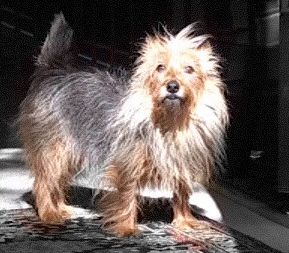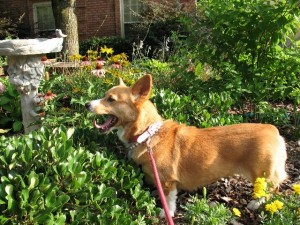Description: The dog moves through an open door on command, on and off leash.
Function: Teach the dog to move through doors on command.
Prerequisites: Condition a reward marker; “Sit”, “Attention – Without Cue”;
Time: 4 Days
Many of my clients complain that their dogs will not enter and exit their houses on command. The dogs ignore their owners, stand and look at their owners, or run away.
Off leash obedience is an advanced skill, even when the dog is in a fenced area. Before you can expect your dog to obey when he or she is 50 feet away, first you should practice when the dog is on a short leash, then a long line.
There are many reasons a dog might not be motivated to obey. Some dogs may prefer the inside because of the weather outside. If an owner has a history of calling their dog inside, placing the dog in the crate, and leaving the house, the dog may remember and be hesitant to come inside. Other dogs like to chase critters and bark at noises outside.
Regardless of the underlying reasons, training and practice is the solution. I use the “Inside – Outside” game to teach dogs to move through doorways. To play the game, follow these suggestions.
First Day:
Place your dog on a 6 foot leash.
Stand inside your house next to an exit door.
Tell your dog to sit. Praise your dog for the sit.
Tell your dog, “Outside”.
Open the door and walk outside. Don’t pull that rascal through the door. Make some “kissy” noises to charm your dog as you and your dog walk through the door to the outside. Mark the instant he or she passes through the doorway.
Close the door.
Drop the leash.
Toss a treat on the ground outside, several feet away from the door.
Pick up the leash.
Tell your dog to sit. Praise your dog for the sit.
Tell your dog, “Inside”.
Open the door and walk inside. Don’t pull that rascal through the door. Use your voice to charm your dog as you and your dog walk through the door to the inside.
Mark the instant he or she passes through the doorway.
Close the door.
Drop the leash.
Toss a treat on the floor inside, several feet away from the door.
Repeat the sequence 2 more times for a total of 6 trials (3 Outside – 3 Inside) during each practice session. Hold 3 of these practice sessions every day. End each session with a walk, a game of fetch, or any of your dog’s favorite play activities.
Next Day:
Play the Inside – Outside game 3 times each day for a total of 18 trials. Practice at each door you plan to enter and exit with your dog during each session. For example, if you use 2 doors, practice the sequence 2 times at 1 door and 1 time at the other door. If you have 3 doors, practice one sequence at each door.
Third Day:
Stand inside your house next to an exit door to a fenced area, with no leash attached.
Call your dog, using the two-finger target.
Mark the instant your dog touches the target and immediately tell your dog to sit. Praise your dog for the sit.
Tell your dog, “Outside”.
Open the door.
Step into the door opening.
Your dog will pass through the door.
Mark the instant he or she passes through the doorway.
Toss a treat on the ground outside, several feet away from the door.
Close the door. Your dog will be on the outside and you will be on the inside.
Immediately walk outside. Close the door.
Call your dog, using the two-finger target.
Mark the instant your dog touches the target and immediately tell your dog to sit. Praise your dog for the sit.
Open the door and tell your dog, “Inside”.
Step into the door opening. Your dog will pass through the door. Mark the instant he or she passes through the doorway.
Toss a treat on the floor inside, several feet away from the door. Close the door. Your dog will be on the inside and you will be on the outside.
Repeat the sequence 2 more times for a total of 6 trials (3 Outside – 3 Inside) during each practice session. Hold 3 of these practice sessions every day. End each session with a walk, a game of fetch, or any of your dog’s favorite play activities.
Fourth Day:
Fade the marker and the food treat, and reduce your motion of moving into the doorway. When your dog moves through the door, offer verbal praise and toss a ball or a toy instead of a treat. You can step inside or outside with your dog, or not.
Stand inside your house next to an exit door to a fenced area, with no leash attached.
Tell your dog to sit. Praise your dog for the sit.
Tell your dog, “Outside”.
Open the door.
Your dog will pass through the door.
Praise your dog.
Toss a ball or toy outside, several feet away from the door.
Close the door. Your dog will be on the outside and you will be on the inside.
Open the door and walk outside. Close the door.
Tell your dog to sit. Praise your dog for the sit.
Open the door and tell your dog, “Inside”.
Your dog will pass through the door.
Close the door. Your dog will be on the inside and you will be on the outside.
Repeat the sequence 2 more times for a total of 6 trials (3 Outside – 3 Inside) during each practice session. Hold 3 of these practice sessions every day. End each session with a walk, a game of fetch, or any of your dog’s favorite play activities.





